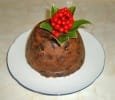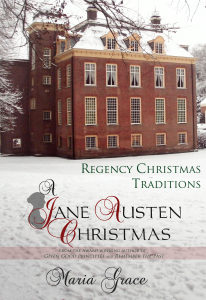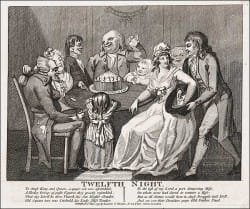Christmas Celebrations as Jane Austen Knew Them
It’s tempting to imagine a young Jane Austen celebrating Christmas around a Christmas tree, exchanging gifts with her siblings, maybe going house to house caroling for the neighbors. However, that image depicts a Victorian Christmas, not a Regency era one. Christmastide celebrations at the tail-end of the Georgian era were very different.
How different? Christmas trees were uncommon. Gifts were not a main focus of festivities. Most events were adult oriented, with children often consigned to the nursery. Holiday events, including balls, parties, dinners, and even weddings celebrations, started a week before Advent (the fourth Sunday before Christmas) and extended all the way through to Twelfth Night in January.
Stir it Up Sunday
So what would young Jane Austen’s celebrations have looked like? They would likely have begun on the fifth Sunday before Christmas. Her family would likely have gathered to make Christmas puddings to serve at Christmas dinner.
The day became known as “Stir Up Sunday,” not because of the stirring done, but because the main prayer in the 1549 Book of Common Prayer for that day began: ‘Stir up, we beseech thee, O Lord, the wills of thy faithful people…’

Christmas pudding was traditionally prepared with thirteen ingredients to represent Christ and the twelve apostles. All family members took a hand in ‘stirring up’ the pudding, using a wooden spoon in honor of Christ’s manger. They stirred clockwise, from east to west, to honor the journey of the Magi, with eyes shut, while making a secret wish.
Tiny charms might be added to the pudding to reveal their finders’ fortune. These included a thimble for spinsterhood or thrift, a ring for marriage, a coin for wealth, a horseshoe or wishbone for good luck, and an anchor for safe harbor. The pudding would be served aflame with a sprig of holly on the top as a reminder of Jesus’ crown of thorns. The flames represented the passion of Christ and Jesus’ love and power and afforded a very theatrical, if somewhat dangerous, presentation.
![Bring in the Boar's Head [Illustrated London News]](https://randombitsoffascination.com/wp-content/uploads/2015/11/Bringing_in_the_Boars_Head.jpg)
Christmas Day
For the Austens, Christmas Day would begin with a trip to church and culminate in a dinner feast, often celebrated with many guests. They might have hosted the feast themselves or been invited to dine with the principle landowner of their parish. This feast, rather than gift giving would be the highlight of the day.
A wide variety of dishes could be prepared, but a few dishes were particularly iconic for the season. Goose was probably the favorite main dish for Christmas dinner. Though not difficult to prepare, the size of the bird often posed challenges for modest kitchens. Local bakers provided a solution, roasting birds for customers to pick up on their way home from Christmas Day services. Apparently ‘take out’ food for holiday meals is not a new idea.
Most considered mince meat pies a staple of the Christmastide season. Leftovers from the feast went to make the pies. Eating minced pie during all twelve days of Christmas was said to bring twelve months of happiness in the new year. To strengthen the charm, the pies must be baked by the dozen and offered by friends. While eating the first mince pie of the season, the eater should make a wish and eat that pie in silence. I wonder what Austen would have wished for.
Boxing Day
St. Stephen’s Day, December 26, now called Boxing Day, was a day for gifts and charity and would likely have been significant in the Austen household.
Old clothing and extra items were boxed up and handed out to servants and tradesmen. Boxes might be prepared for the less fortunate of the parish. Churches also collected money in alms-boxes during the season and distributed it to the needy after Christmas.
Boxing day was also considered a kick-off point for pantomimes and other seasonal activities that would continue until Twelfth Night. The Austens could have looked forward to trips to the local theater, home theatricals, parties, dinners and even balls.
Welcoming in the New Year
New Year’s celebrations varied from one family to the next. Since Austen never really wrote about New Year’s it is difficult to know what her family might have done. One possibility is that the Austens gathered in the parlor just before midnight. At the stroke of midnight, Mr. Austen would open the front and back doors to usher out the old year and welcome the new. They might have done some cleaning in anticipation, removing ashes, rags, scraps and anything perishable from the house so nothing was carried over from one year to the next, preserving good luck and banishing any bad
Twelfth Night
Epiphany or Twelfth Night was the climax of the season, a time for putting away social norms and marking the coming of the Magi with a feast and possibly an exchange of gifts.
(to the left, Isaac Cruikshank‘s1794 illustration)
Parties were the order of the day and night. The Austens might have hosted their own event or attended neighborhood events. Elaborate and expensive Twelfth day cakes would have been served amidst the parlor games, dancing and sometimes very rowdy celebrations.
Twelfth Night parties commonly featured each guest selecting a random character by drawing a slip of paper when they arrived. Some hostesses would send characters around to guests so that they could come already dressed to play the part. Others might provide dress up items for their guests to don after characters had been chosen. Guests remained in character for the entire evening and paid a forfeit if they broke out of character during the night.
In addition to the obligatory King and Queen, characters included some from popular literature and plays as well as standard characters like Sir Gregory Goose, Sir Tumbelly Clumsy, Miss Fanny Fanciful and Mrs. Candour. Sets of pre-made characters could be purchased from stationers, or a family might copy them from books on merry-making.
Games like Snapdragon might be played during the evening. In Snapdragon, raisins would be piled in a bowl, topped with brandy and lit on fire. Players would try to snatch raisins out of the blue brandy-flames and eat them without getting burned—or lighting anything else aflame. The player with the most raisins was destined to find true love in the upcoming year. Jane Austen played spillikins—I wonder if that skill would translate to snapdragon?
Some of these old-fashioned ideas sound like a great deal of fun! I am seriously thinking about hosting a Twelfth Night party this year, minus the flaming raisins, though.



Such an incredible words, thanks for sharing such a lovely heartwarming blog.